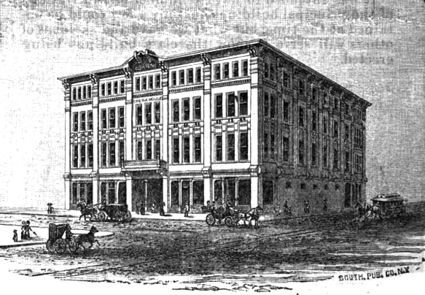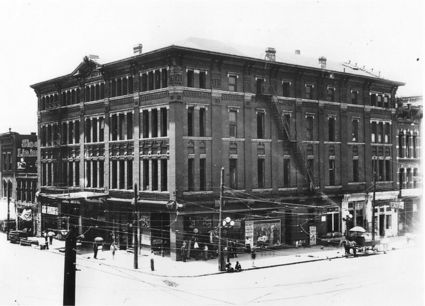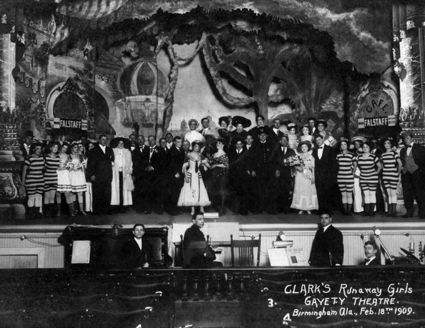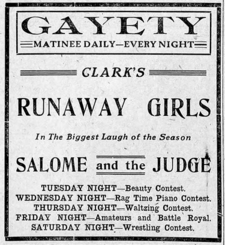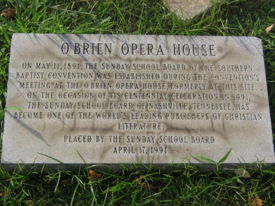O'Brien's Opera House: Difference between revisions
No edit summary |
|||
| (33 intermediate revisions by 3 users not shown) | |||
| Line 1: | Line 1: | ||
[[Image:O'Brien's Opera House.jpg|right|425px|thumb|O'Brien's Opera House]] | [[Image:O'Brien's Opera House.jpg|right|thumb|425px|O'Brien's Opera House]] | ||
[[Image:O'Brien's Opera House photo.jpg|right|thumb|425px|Undated photo of O'Brien's Opera House]] | |||
[[Image:Grambs' Orchestra 1890s.jpg|right|thumb|425px|[[Grambs' Orchestra]] posing outside the Opera House]] | |||
[[Image:Clark's Runaway Girls at the Gayety 1909-02-18.jpg|right|thumb|425px|Clark's Runaway Girls on stage at the Gayety in February 1909]] | |||
'''O'Brien's Opera House''' (or '''The O'Brien Opera House''') was a "gas light" theater located at the northwest corner of [[1st Avenue North|1st Avenue]] and [[19th Street North]] in downtown [[Birmingham]]. The theater was constructed for traveling theatrical troupes by [[Frank O'Brien]], who would later be [[Jefferson County Sheriff|sheriff]] and [[Mayor of Birmingham|mayor]]. | '''O'Brien's Opera House''' (or '''The O'Brien Opera House''') was a "gas light" theater located at the northwest corner of [[1st Avenue North|1st Avenue]] and [[19th Street North]] in downtown [[Birmingham]]. The theater was constructed for traveling theatrical troupes by [[Frank O'Brien]], who would later be [[Jefferson County Sheriff|sheriff]] and [[Mayor of Birmingham|mayor]]. | ||
__NOTOC__ | __NOTOC__ | ||
==Development== | ==Development and layout== | ||
O'Brien bought the property, 125 feet of frontage on 1st Avenue then occupied by a sawmill operated by [[Thomas Jeffers]] and [[George Thomas]] in [[1878]], paying what was considered an exorbitant sum of $ | O'Brien bought the property, 125 feet of frontage on 1st Avenue then occupied by a sawmill operated by [[Thomas Jeffers]] and [[George Thomas]] in [[1878]], paying what was considered an exorbitant sum of $750. Construction of his palatial four-story brick theater building commenced in May [[1882]] and was completed that November. He purchased brick from [[T. M. D. Erhart]]'s yard south of [[Bessemer]] and lumber from a yard at [[1st Avenue South|Avenue A]] and [[17th Street South|17th Street]]. | ||
The 1,250-seat auditorium itself was located on the second floor of the building. It was 49-feet wide with a 40-foot deep stage open to a 28½-foot wide by 36-foot tall proscenium with another 4½-feet between the curtain and the footlights. The roof was 55 feet above the stage with three feet below it to the rigging loft. Nine feet was available below the stage for traps. The hall utilized gas burners, incandescent lights, and arc lights. | |||
In addition to the auditorium, the building housed ground floor shops such as [[George Pappa]]'s saloon and the [[Dunnam Brothers]] grocery store. The ground floor of the Opera House building was used for retail stores. [[Samuel Ullman]]'s hardware business and the [[Eubanks Brothers]] dentistry office were also located there. A hotel occupied the upper floors, charging $1.25 per night in the late 1890s. | |||
==Opening== | ==Opening== | ||
The inaugural performance at the Opera House was a production of Charles Barras' ''The Black Crook'' staged on [[November 14]], [[1882]] by the Huntley, Blaisdell and Brown Company. Under O'Brien's management the hall featured "high-brow" dramatic and musical performances. Entertainers who graced the stage included Joseph Jefferson, Edwin Forrest, Roger Busfield, Roe Coglan and the Thatcher, Primrose and West minstrels. A new tile floor for the lobby was installed as a gift from [[ | The inaugural performance at the Opera House was a production of Charles Barras' ''The Black Crook'' staged on [[November 14]], [[1882]] by the Huntley, Blaisdell and Brown Company. Under O'Brien's management the hall featured "high-brow" dramatic and musical performances. Entertainers who graced the stage included Joseph Jefferson, Edwin Forrest, Roger Busfield, Roe Coglan and the Thatcher, Primrose and West minstrels. | ||
Bandleader [[Fred Grambs]] and partner [[Ben Theiss]] began leasing and managing the theater in [[1884]]. A new tile floor for the lobby was installed as a gift from [[Charles Pierce]], builder of the new [[L & N Station]], in November [[1886]]. The venue was also used as a meeting house for many different groups. The [[Birmingham Regional Chamber of Commerce|Birmingham Chamber of Commerce]] was organized at the O'Brien on [[May 14]], [[1887]]. The Sunday School Board of the Southern Baptist Convention was created during a conference at the O'Brien on [[May 11]], [[1891]]. Later that year, Augustus Thomas' critically-acclaimed debut, ''[[Alabama (play)|Alabama]],'' was staged at the Opera House by A. M. Palmer's company. Local reviewers found the story line, which took place in [[Reconstruction]]-era [[Talladega]], to be historically incorrect. | |||
The interior was fully renovated in [[1889]], with carpeting installed by the [[J. M. Wharton Furniture Company]]. | |||
In [[1892]] Henry Mapleson's Opera Company of London, England came to Birmingham to stage ''Fadette'' an adaptation by Tito Mattei of Aimé Maillart's "Les dragons de Villars" (itself based on Georges Sand's novel "La Petite Fadette"), which starred Laura Mapleson and Charles H. Drew. The Deshon Opera Company were residents at the Opera House during the [[1893]] season, and Sam T. Jack's Creole Burlesque Company caused a sensation that October with its primarily African-American cast. | |||
==Sale== | ==Sale== | ||
In [[1895]] [[Charles Whelan]] purchased the theater at a mortgage sale. He retained | In [[1895]] [[Charles Whelan]] purchased the theater at a mortgage sale. He retained the lease to Theiss and Grambs and enlarged the stage. In December [[1898]], Whelan's death led to another sale. [[A. L. Fulenwider]] and [[Henry Badham Sr]] purchased it from his estate for $60,000 and embarked on a major overhaul, which included lowering the stage to the ground floor and remodeling the hotel. Theiss and Grambs were retained as lessees. | ||
The [[Jefferson Theatre]] opened nearby on [[2nd Avenue North]] in March [[1900]]. Many of the vaudeville shows and group meetings that would have played the O'Brien moved to the newer hall. In [[1905]] the Columbia Amusement Company secured a lease on the theater and installed huge electrified signs across [[1st Avenue North]] and [[19th Street North|19th Street]] to advertise its newly-renamed '''Gayety Theatre'''. Manager [[E. A. McArdle]] circumvented the city's new ordinance against burlesque entertainments simply by not using that word in his advertising. Nevertheless, on [[January 5]], [[1909]] [[Birmingham Police Department|Birmingham Police]] detective [[George Bodeker]] issued a formal warning: "I like to see a good show and enjoy it, but at the same time I will not tolerate any such movements as I saw this afternoon and I assure you that if this occurs tonight, I will most assuredly put the entire troupe under bond." | On [[March 2]], [[1898]] the Opera House hosted a much-anticipated lecture by Democratic Party leader William Jennings Bryan. Grambs' band escorted Bryan from his train to the [[Morris Hotel]] at his early afternoon arrival. | ||
Fulenwider and Badham, sold the theater on [[March 28]], [[1899]] to [[Joseph R. Smith Jr]] and [[Charles J. Smith]] for $75,000. This time Theiss and Grambs lost their lease and the Jefferson, Klaw and Erlanger firm of New York took over management. New Orleans architect Thomas Sully was engaged to prepare plans for an interior remodeling of the opera house scheduled for the summer. | |||
The [[Jefferson Theatre]] opened nearby on [[2nd Avenue North]] in March [[1900]]. Many of the vaudeville shows and group meetings that would have played the O'Brien moved to the newer hall. In [[1905]] the Columbia Amusement Company secured a lease on the theater and installed huge electrified signs across [[1st Avenue North]] and [[19th Street North|19th Street]] to advertise its newly-renamed '''Gayety Theatre'''. Manager [[E. A. McArdle]] circumvented the city's new ordinance against burlesque entertainments simply by not using that word in his advertising. Nevertheless, on [[January 5]], [[1909]] [[Birmingham Police Department|Birmingham Police]] detective [[George Bodeker]] issued a formal warning: "I like to see a good show and enjoy it, but at the same time I will not tolerate any such movements as I saw this afternoon and I assure you that if this occurs tonight, I will most assuredly put the entire troupe under bond." | |||
[[Image:1900 Gayety ad.png|left|thumb|225px|February 1900 ad for the Gayety]] | |||
A [[February 13]] advertisement offered "Clark's Runaway Girls" burlesque as the headline act. According to the ''[[Birmingham News]]'', Clark's troupe was "one of the best and cleanest extravaganza companies extant", offering "neither a suggestive word or action that would tend to offend anyone. The evening was padded out with a dramatic performance of "Salome and the Judge", a Bowery Comedy quartet, Crawford & Manning's blackface grotesque, the famous Livingstons, European Risley acrobats, Perry & Elliot's song and dance, Estella Rose the "magnetic French dancer", and other Vaudeville acts. The rest of the week featured a beauty contest, a rag time piano contest, a waltzing contest, amateur boxing, and Saturday night wrestling. The increased scrutiny did not help the business, which closed on [[April 17]] of that year. | |||
By [[1905]] '''The New Gayety''' was again featuring provocative acts featuring "Catchy Music—New Songs—Pretty Girls", and well as a daily ladies' matinee starring the "Bachelor's Club Burlesquers". | |||
==Last days== | ==Last days== | ||
[[Image:ObrienOperaHouse.jpg|left|275px|thumb|Plaque commemorating the O'Brien Opera House on 1st Avenue and 19th Street North]] | [[Image:ObrienOperaHouse.jpg|left|275px|thumb|Plaque commemorating the O'Brien Opera House on 1st Avenue and 19th Street North]] | ||
On [[May 3]], the theater was reopened as the O'Brien Opera House again, but the next season it changed its name to '''The Virginia'''. The Shubert Organization acquired the lease in [[1910]], renaming the hall '''The Shubert Theater''' and refurbished it for a return to grand entertainment. The new management was so successful that they | On [[May 3]], 1909 the theater was reopened as the O'Brien Opera House again, but the next season it changed its name to '''The Virginia'''. The Shubert Organization acquired the lease in [[1910]], renaming the hall '''The Shubert Theater''' and refurbished it for a return to grand entertainment. The new management was so successful that they occasionally had to lease the larger [[Orpheum Theater]] for certain programs, such as Bessie Abott's performance in Puccini's "La Bohème" (a tour that finally succumbed to poor receipts and completed its run in Birmingham). The [[Shubert Theatre Orchestra]] was managed by [[H. E. Snow]]<!--http://digital.archives.alabama.gov/cdm/ref/collection/photo/id/18120-->. | ||
Despite the theater's newfound success with "legitimate" theater, the [[Birmingham Fire and Rescue Service|Birmingham Fire]] chief declared the building unsafe on [[May 31]], [[1911]]. It was never reopened, and was finally torn down in [[1915]]. Some of the bricks were shipped to [[University of Montevallo|Alabama College]] in [[Montevallo]] and re-used in the construction of a gymnasium. | |||
The [[Molton-Henley Retail Block]] was later built on the site. In [[1951]] [[Sokol's]] discount store at 1818 [[1st Avenue North (Downtown)1st Avenue North]]]] expanded eastward. Those structures were also demolished for parking. | |||
A marker, donated by O'Brien's daughter [[Bossie O'Brien Hundley|Bossie]] and then-property owner [[Ellen Hickman]], was erected on the site of the former opera house in [[1950]]. Another marker from the [[Southern Baptist Convention Sunday School Board]] was placed there on [[April 17]], [[1991]]. | |||
==Tenants== | |||
* 1st Avenue North: | |||
** 1824–1830: former location of [[Opera House Hotel]] (1898) | |||
*** 1824: former location of dining room (1891), [[Thiess & Smith]] billposters (1898) | |||
*** 1826: former location of office (1891) | |||
*** 1828: former location of [[H. Lowenthal]] grocer (1887), [[William J. Lemp Brewing Co.]] (1897), [[Opera House Bar]] (1898–1899), [[Battle Creek Turkish Bath & Barber Shop]] ([[J. J. Pearson]] 1902), [[Kartus & Weinstein]] (1904) | |||
*** 1830: former location of [[G. W. Shackleford]] saloon (1887), [[George Raps]] saloon (1883-1891), [[Henrietta Peterson]] saloon (1904) | |||
** 1832-1834: former location of clothier (1891), [[Sommer Tailoring Co.]] (1896–1898) | |||
* 19th Street North: | |||
** 100–106: former location of clothing store (1891), [[Summer Tailoring Co.]] (1897) | |||
*** corner: former location of [[Gus Jebeles]] cigar store (1907–1911) | |||
*** 100: [[Alex Kontos]] / [[S. Kohn]] (1911) | |||
*** 106: former location of [[DuMont & Knox]] insurance / [[Howell, Randolph & Howell]] real estate (1887), [[Riverside Cafe]] (1909) | |||
** 108: former location of [[Bessemer Land & Improvement Co.]] / [[H. F. DeBardeleben]] real estate (1887), barber (1891), [[Avondale Steam Laundry]] / [[J. H. Heineke]] insurance & real estate / [[Alabama Building & Loan Association]] (1897), [[John Balabanos]] / [[Paul Lekas]] (1907), [[Peter Govatos]] (1907), [[Riverside Cafe]] (1911) | |||
** 110: former location of [[Birmingham Shoe Hospital]] (1911) | |||
==References== | ==References== | ||
* "[https://www.newspapers.com/article/the-birmingham-news-around-the-town/138192357/ Around The Town]." (May 19, 1899) {{BN}}, p. 4 | |||
* "At the Gayety" (February 13, 1909) {{BN}} | |||
* Chiles, Ruth (1936) "The Birmingham Theatres, 1886-1900". M.A. thesis, Birmingham-Southern College | * Chiles, Ruth (1936) "The Birmingham Theatres, 1886-1900". M.A. thesis, Birmingham-Southern College | ||
* Haarbauer, Donald Ward (1973) ''A critical history of the non-academic theatre in Birmingham, Alabama.'' Ph.D. dissertation. University of Wisconsin. | * Haarbauer, Donald Ward (1973) ''A critical history of the non-academic theatre in Birmingham, Alabama.'' Ph.D. dissertation. University of Wisconsin. | ||
| Line 31: | Line 73: | ||
{{DEFAULTSORT:O'Brien Opera House}} | {{DEFAULTSORT:O'Brien Opera House}} | ||
[[Category:O'Brien Opera House|*]] | |||
[[Category:1882 establishments]] | [[Category:1882 establishments]] | ||
[[Category:1910 disestablishments]] | [[Category:1910 disestablishments]] | ||
[[Category:1882 buildings]] | [[Category:1882 buildings]] | ||
[[Category: | [[Category:1915 demolitions]] | ||
[[Category:Theaters]] | [[Category:Theaters]] | ||
Latest revision as of 11:41, 16 January 2024
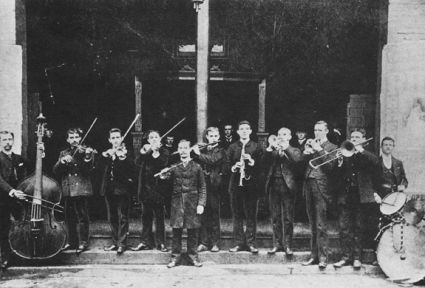
O'Brien's Opera House (or The O'Brien Opera House) was a "gas light" theater located at the northwest corner of 1st Avenue and 19th Street North in downtown Birmingham. The theater was constructed for traveling theatrical troupes by Frank O'Brien, who would later be sheriff and mayor.
Development and layout
O'Brien bought the property, 125 feet of frontage on 1st Avenue then occupied by a sawmill operated by Thomas Jeffers and George Thomas in 1878, paying what was considered an exorbitant sum of $750. Construction of his palatial four-story brick theater building commenced in May 1882 and was completed that November. He purchased brick from T. M. D. Erhart's yard south of Bessemer and lumber from a yard at Avenue A and 17th Street.
The 1,250-seat auditorium itself was located on the second floor of the building. It was 49-feet wide with a 40-foot deep stage open to a 28½-foot wide by 36-foot tall proscenium with another 4½-feet between the curtain and the footlights. The roof was 55 feet above the stage with three feet below it to the rigging loft. Nine feet was available below the stage for traps. The hall utilized gas burners, incandescent lights, and arc lights.
In addition to the auditorium, the building housed ground floor shops such as George Pappa's saloon and the Dunnam Brothers grocery store. The ground floor of the Opera House building was used for retail stores. Samuel Ullman's hardware business and the Eubanks Brothers dentistry office were also located there. A hotel occupied the upper floors, charging $1.25 per night in the late 1890s.
Opening
The inaugural performance at the Opera House was a production of Charles Barras' The Black Crook staged on November 14, 1882 by the Huntley, Blaisdell and Brown Company. Under O'Brien's management the hall featured "high-brow" dramatic and musical performances. Entertainers who graced the stage included Joseph Jefferson, Edwin Forrest, Roger Busfield, Roe Coglan and the Thatcher, Primrose and West minstrels.
Bandleader Fred Grambs and partner Ben Theiss began leasing and managing the theater in 1884. A new tile floor for the lobby was installed as a gift from Charles Pierce, builder of the new L & N Station, in November 1886. The venue was also used as a meeting house for many different groups. The Birmingham Chamber of Commerce was organized at the O'Brien on May 14, 1887. The Sunday School Board of the Southern Baptist Convention was created during a conference at the O'Brien on May 11, 1891. Later that year, Augustus Thomas' critically-acclaimed debut, Alabama, was staged at the Opera House by A. M. Palmer's company. Local reviewers found the story line, which took place in Reconstruction-era Talladega, to be historically incorrect.
The interior was fully renovated in 1889, with carpeting installed by the J. M. Wharton Furniture Company.
In 1892 Henry Mapleson's Opera Company of London, England came to Birmingham to stage Fadette an adaptation by Tito Mattei of Aimé Maillart's "Les dragons de Villars" (itself based on Georges Sand's novel "La Petite Fadette"), which starred Laura Mapleson and Charles H. Drew. The Deshon Opera Company were residents at the Opera House during the 1893 season, and Sam T. Jack's Creole Burlesque Company caused a sensation that October with its primarily African-American cast.
Sale
In 1895 Charles Whelan purchased the theater at a mortgage sale. He retained the lease to Theiss and Grambs and enlarged the stage. In December 1898, Whelan's death led to another sale. A. L. Fulenwider and Henry Badham Sr purchased it from his estate for $60,000 and embarked on a major overhaul, which included lowering the stage to the ground floor and remodeling the hotel. Theiss and Grambs were retained as lessees.
On March 2, 1898 the Opera House hosted a much-anticipated lecture by Democratic Party leader William Jennings Bryan. Grambs' band escorted Bryan from his train to the Morris Hotel at his early afternoon arrival.
Fulenwider and Badham, sold the theater on March 28, 1899 to Joseph R. Smith Jr and Charles J. Smith for $75,000. This time Theiss and Grambs lost their lease and the Jefferson, Klaw and Erlanger firm of New York took over management. New Orleans architect Thomas Sully was engaged to prepare plans for an interior remodeling of the opera house scheduled for the summer.
The Jefferson Theatre opened nearby on 2nd Avenue North in March 1900. Many of the vaudeville shows and group meetings that would have played the O'Brien moved to the newer hall. In 1905 the Columbia Amusement Company secured a lease on the theater and installed huge electrified signs across 1st Avenue North and 19th Street to advertise its newly-renamed Gayety Theatre. Manager E. A. McArdle circumvented the city's new ordinance against burlesque entertainments simply by not using that word in his advertising. Nevertheless, on January 5, 1909 Birmingham Police detective George Bodeker issued a formal warning: "I like to see a good show and enjoy it, but at the same time I will not tolerate any such movements as I saw this afternoon and I assure you that if this occurs tonight, I will most assuredly put the entire troupe under bond."
A February 13 advertisement offered "Clark's Runaway Girls" burlesque as the headline act. According to the Birmingham News, Clark's troupe was "one of the best and cleanest extravaganza companies extant", offering "neither a suggestive word or action that would tend to offend anyone. The evening was padded out with a dramatic performance of "Salome and the Judge", a Bowery Comedy quartet, Crawford & Manning's blackface grotesque, the famous Livingstons, European Risley acrobats, Perry & Elliot's song and dance, Estella Rose the "magnetic French dancer", and other Vaudeville acts. The rest of the week featured a beauty contest, a rag time piano contest, a waltzing contest, amateur boxing, and Saturday night wrestling. The increased scrutiny did not help the business, which closed on April 17 of that year.
By 1905 The New Gayety was again featuring provocative acts featuring "Catchy Music—New Songs—Pretty Girls", and well as a daily ladies' matinee starring the "Bachelor's Club Burlesquers".
Last days
On May 3, 1909 the theater was reopened as the O'Brien Opera House again, but the next season it changed its name to The Virginia. The Shubert Organization acquired the lease in 1910, renaming the hall The Shubert Theater and refurbished it for a return to grand entertainment. The new management was so successful that they occasionally had to lease the larger Orpheum Theater for certain programs, such as Bessie Abott's performance in Puccini's "La Bohème" (a tour that finally succumbed to poor receipts and completed its run in Birmingham). The Shubert Theatre Orchestra was managed by H. E. Snow.
Despite the theater's newfound success with "legitimate" theater, the Birmingham Fire chief declared the building unsafe on May 31, 1911. It was never reopened, and was finally torn down in 1915. Some of the bricks were shipped to Alabama College in Montevallo and re-used in the construction of a gymnasium.
The Molton-Henley Retail Block was later built on the site. In 1951 Sokol's discount store at 1818 1st Avenue North (Downtown)1st Avenue North]] expanded eastward. Those structures were also demolished for parking.
A marker, donated by O'Brien's daughter Bossie and then-property owner Ellen Hickman, was erected on the site of the former opera house in 1950. Another marker from the Southern Baptist Convention Sunday School Board was placed there on April 17, 1991.
Tenants
- 1st Avenue North:
- 1824–1830: former location of Opera House Hotel (1898)
- 1824: former location of dining room (1891), Thiess & Smith billposters (1898)
- 1826: former location of office (1891)
- 1828: former location of H. Lowenthal grocer (1887), William J. Lemp Brewing Co. (1897), Opera House Bar (1898–1899), Battle Creek Turkish Bath & Barber Shop (J. J. Pearson 1902), Kartus & Weinstein (1904)
- 1830: former location of G. W. Shackleford saloon (1887), George Raps saloon (1883-1891), Henrietta Peterson saloon (1904)
- 1832-1834: former location of clothier (1891), Sommer Tailoring Co. (1896–1898)
- 1824–1830: former location of Opera House Hotel (1898)
- 19th Street North:
- 100–106: former location of clothing store (1891), Summer Tailoring Co. (1897)
- corner: former location of Gus Jebeles cigar store (1907–1911)
- 100: Alex Kontos / S. Kohn (1911)
- 106: former location of DuMont & Knox insurance / Howell, Randolph & Howell real estate (1887), Riverside Cafe (1909)
- 108: former location of Bessemer Land & Improvement Co. / H. F. DeBardeleben real estate (1887), barber (1891), Avondale Steam Laundry / J. H. Heineke insurance & real estate / Alabama Building & Loan Association (1897), John Balabanos / Paul Lekas (1907), Peter Govatos (1907), Riverside Cafe (1911)
- 110: former location of Birmingham Shoe Hospital (1911)
- 100–106: former location of clothing store (1891), Summer Tailoring Co. (1897)
References
- "Around The Town." (May 19, 1899) The Birmingham News, p. 4
- "At the Gayety" (February 13, 1909) The Birmingham News
- Chiles, Ruth (1936) "The Birmingham Theatres, 1886-1900". M.A. thesis, Birmingham-Southern College
- Haarbauer, Donald Ward (1973) A critical history of the non-academic theatre in Birmingham, Alabama. Ph.D. dissertation. University of Wisconsin.
- "O'Brien Opera House — On Its Old Site Will Stand Marker" (January 1950) The Birmingham News - via Birmingham Rewound
- Showplaces of the South Pt. 2 at Birmingham Rewound, accessed August 8, 2007.
External links
- Gayety Theatre at bplonline.com
